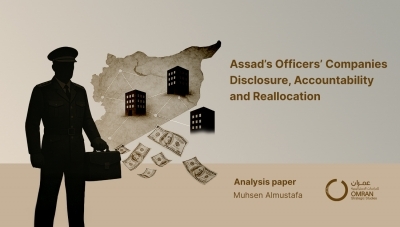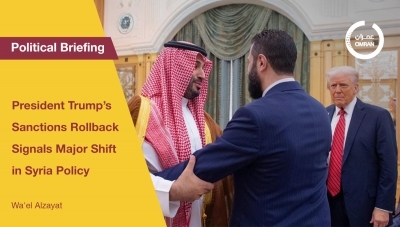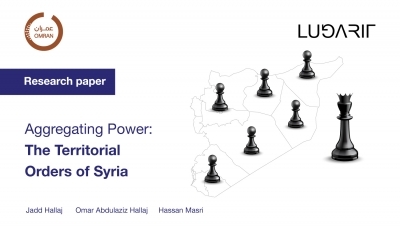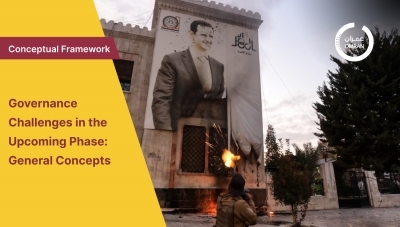Omran News
Centralization and Decentralization in Syria: Concepts and Practices
Introduction
After seven years of conflict between the people and the Assad regime, Syria is now going through a difficult phase. The nature of the conflict has transformed whereby the role and effectiveness of local actors has been greatly maringalized compared to an increasing role for international state and non-state actors. The role of armed opposition factions has diminished as international military, administrative, and political influence has grown. These armed opposition actors are also in a phase of turmoil as they struggle to survive or integrate under direct international custodianship, after having previously received support from the Northern or Southern Operations Rooms. This process follows the series of meetings in Astana and Sochi, and after the political bodies were domesticated into official negotiating bodies that support the interests of countries with direct influence over them. At the same time, direct Russian influence came to dominate the political, military, economic, and administrative spheres. As a result, the concept of the unified framework of the "regime platform" versus the "opposition platform" in accordance with the Geneva II concept was discarded through the creation of several negotiating platforms on the sides of the opposition, the regime, and the Syria Democratic Forces (SDF).
At the same time as these political changes were happening, the areas of influence and control on the ground were consolidated in 2018 into the north and northwestern portion under Turkish control, the northeast under the U.S. and SDF control, and southwestern Syria under the influence of the U.S. and Jordan, allowing Israel to strike any sites that it deems threatening. The areas of siege and opposition group control have been eliminated. International and regional influence has thus become more distinct, as efforts to control and integrate both armed opposition and pro-government groups continue.
This new phase is characterized by a complex series of partial deals that build on one another, and the arrangements among the state actors are developing in a "step by step" policy approach. The "counter-terrorism" framework that was used to justify the entry of these countries into Syria, is no longer a justification for their continued presence and influence: the U.S. is increasingly focused on the "Iranian threat;" Turkey is focused on "fighting the PKK" and security its borders; Israel justifies its interventions with the need to protect its borders against the "Iranian threat" and to prevent the transfer of weapons and fighters toward its borders; and Jordan is now also interested in protecting itself against the “Shi’ite crescent".
In light of this new landscape, contributing writers to this book discuss several aspects of Syria's current form of governance and how experiences on the ground in the different areas of influence converge or diverge from the concepts of centralization and decentralization, both vertically and horizontally. Towards this end, the chapters of this book first clarify the concepts and forms of decentralization and the way they are applied in post-conflict countries. They highlight the important role that agreeing on the form of governance and power sharing is an important factor in maintaining territorial unity and in shepherding negotiations to a more relevant stage of the new post-conflict reality. Next, the authors delineate decentralization in terms of its political, security, financial, and developmental functions, and review the constitutional and legal foundations of administrative and political decentralization in Syria. Finally, the authors present the experiences and applications of governance since 2011 in the regime-controlled areas and opposition-controlled areas, as well as in the SDF-controlled in northeast areas of the Democratic Autonomous Administration. Woven throughout the book are comparative descriptions of the experiences from Iraq, Lebanon, and other countries emerging from conflict, to see what lessons can be learned from the ways that these countries have negotiated the distribution of powers between central and local administrative units.
This book aims to help lay out a path towards the restoration of the legitimacy lost by all parties in Syria through the organization of local governance tools based on the experience of local councils. Local councils have tended neither towards excessive forms of decentralization nor to authoritarian centralization, but have instead followed a path that strengthens local structures and sets limits to central state authorities by granting powers rather than delegating them. At this stage, it is essential to work in parallel on strengthening the central government while also safeguarding and reinforcing the gains of the local councils through constitutional guarantees and a new local governance law. This book also stems from recognition of the need to shift away from limited centralized negotiations among the two “sides of the conflict” through a constitutional process followed by general elections, towards a negotiation based on power-sharing arrangements. Local governing bodies and other local actors should be engaged in the process of deciding which functions and authorities are mandated to the central institution versus the local governing units.
The chapters of this book were contributed by several researchers who differ in their approaches, but they all agree on the need to develop a decentralized Syrian model that avoids the reductive binary approach of political decentralization / administrative decentralization or federalism, and one that is based on the sharing of powers and functions, thus transitioning Syria’s system of governance from local administration to local governance. There is no doubt that further development and discussion of these ideas is required, but we present this effort as a starting place for a dialogue in the Syrian community on the most authentic or locally developed form of governance for Syria, which after years of adhoc decentralization, has become more localized than ever before.
Finally, it is important to note that most chapters were written in late 2017 and early 2018, which was before the change of control of Damascus suburb, northern Homs and the southern front. The arguments for a tailored and customized Syria-centric decentralization model put forth are still valid regardless of the controlling armed party.
Executive Summary
Chapter one of the book focuses on the concept of decentralization and illustrates the differences among countries when it comes to choosing how they exercise administrative authority. Every country’s approach to governance is influenced by its political and social conditions, as well as the maturity and depth of its democratic practices. The need to shift towards a decentralized system becomes apparent after examining factors related to a state’s nature, size, and degree of political stability. Decentralization becomes a necessity for stability in some countries because of its core idea: the distribution of power and functions of state institutions between the central governments and local administrative units. This conceptualization reaffirms the fact that the transformation to fully decentralized system may be risky for many governments, despite the promise that decentralization holds as the solution for most conflicts in developing countries such as those in the Arab world. Chief among these problems is the need to expand the political and economic participation of citizens. Still, given the ethnic and sectarian diversity and complex nature of countries, decentralization can be a threat to state unity.
Chapter two describes political functions of the state in a decentralized system and how it is practiced in different versions of decentralization. Political functions of the state take many forms depending on the degree of decentralization and mode of local governance. The far end of a decentralized governance system continuum appears in the practice of full political decentralization (full federalism), where provinces and regions have their individual constitutions and laws, exercise special legislative, executive, and judicial powers, and influence federal government policy through a political oversight authority and through their representatives in the legislative branch councils. Local governments, meanwhile, exercise specific roles in these functions under the partial political decentralization within their constitutionally-vested authority. These roles are primarily related to domestic policy-making and the development of local rules and regulations that do not contradict federal legislations. In administrative decentralization modes of governance, the practice of political functions and duties is reduced to a great extent as it focusses exclusively on administrative and executive functions of local governing institutions. Local administrative units would then be fully subordinated and controlled by the central administration in the capital. In partial administrative decentralization modes of local governance, political functions completely disappear from local units.
According to chapter three of this book, the exercise of legislative and judicial functions within a decentralized system will require reforms in the Syrian judicial branch, such as: the restructuring of the Supreme Judicial Council to ban the executive branch from holding membership in it and stop its interference, and the repeal of laws that encroach on public rights and freedoms with judicial not executive branch oversight. Assessing the current form and content of the Syrian Constitution in terms of centralized or decentralized approaches highlights centralism as highly visible and grants authority to the presidency (which has broad constitutional powers) to override all other authorities and functions of the state. Instead, the principles of separation and distribution of powers should be applied to three independent bodies in order to create balance and cooperation between them. With regard to legislative duties in Syria, this paper shows that the Constitution has broadly granted legislative duties to the People's Council of Syria (Parliament) and the President of the Republic, transforming the mandate of the Parliament from drafting laws to ratification of presidential laws. Reforming this imbalanced structure requires redefining the scope and mandate of the Parliament, abolishing the broad powers granted to the President, and reducing the centrality of legislation process and parliament. There needs to be a shift toward some kind of decentralization that divides future legislative functions in a balanced approach between the exclusive jurisdiction of the legislative branch, and the jurisdiction of the executive branch for all that is not stated in text of the constitution.
The fourth chapter focuses on security functions in decentralized systems. In the context of conflict-ridden or post-conflict countries, it is critical and necessary to re-assess national security functions: their applications, mechanisms for implementation and governance, and how security roles are distributed at different levels of government. This paper emphasizes that the redistribution of security duties and authorities in decentralized countries (in accordance with the lessons from stable and unstable countries) may result in a more efficient and coherent security architecture depending on who and how such a process is executed and whether by means of national actors, cross boarder actors, or international actors. In the search for a governing framework of the Syrian security sector within a decentralized system, independent intelligence agencies should have a clear mandate of intelligence gathering only (except for police forces and anti terrorism units that can arrest citizens) and an identified geographical jurisdiction. Local governing bodies should be constitutionally mandated to provide local security services and conduct police functions and duties locally. The assessment and identification of security threats and risks and the counter strategy to such risks should be developed locally and shared with central agencies for coordination.
The fifth chapter highlights the dialectical relationship between decentralization and its role in local development in countries emerging from conflict. Local development is one of the most important determining factors in whether or not decentralization is adopted in these cases. While some of post-conflict countries have reached acceptable rates of economic and social development after moving to a decentralized system, others have not. This disparity may be due to factors linked to each country’s particular local development process and adopted form of decentralization. This paper emphasizes that in the context of the Syrian situation, the country has suffered from the absence of a clear developmental model for decades. This has led to major developmental imbalances at the central state level, which are most evident in the developmental disparities between Syrian governorates. The adoption of a model of administrative decentralization in Syria will help to mitigate this disparity by empower local communities to participate in the local development process.
The sixth chapter, which deals with financial decentralization, emphasizes the fact that the successful implementation of decentralized systems of government in post-conflict countries depends largely on their ability to establish regulatory frameworks for financial decentralization and mechanisms for the collection, distribution, and disbursement of financial resources at various levels of government and administration. Successful implementation also requires substantial reforms in fiscal policy in general and in spending policies in particular. This paper finds that that the model for allocating financial resources to the local administrative units out of the state budget in Syria has many flaws. It is necessary to grant administrative units greater financial independence and to define metrics for successful financial decentralization to measure whether these units are meeting developmental requirements and making effective contributions to economic and social stability in their regions.
The seventh chapter examines the reality of local administration in regime-controlled areas. It illustrates the dominance of the central government in the local administration systems in regime-controlled areas, the growing influence of the Baath party, and the increasing influence of local Iran-backed forces in the operations of some local administrative units. This paper finds that the service sector crises in the areas of local administration units are indicative of their lack of funding, dysfunctional mechanisms, and insufficient personnel, forcing them to rely on the central government to conduct their affairs. It also argues that the regime is not interested in decentralization – which runs counter to its desire to retain centralized control – but it does use decentralization politically as a bargaining chip for negotiations with the international community, particularly the Europeans. The regime also attempted to manipulate the boundaries of the electoral constituency of administrative units to change administrative districts and weaken opposition areas by preventing them from winning elections in their areas while rewarding loyalists.
The eighth chapter focuses on the reality of governance in Syrian opposition-controlled areas. It reaches several conclusions, the most important of which is that local councils have undergone changes in terms of structure, mechanisms of formation, and function, as their organizational structures have stabilized and they rely increasingly on the elections for their membership. They have also been able to consolidate their service roles, compared to their role in local security and politics. The financial file is one of the primary challenges facing local councils as they cope with growing financial deficits, due both to the nature of revenues and expenditures, and also their lack of financial systems or laws regulating their budgets. This chapter explains how the long duration of the conflict, the transformations in its nature, the push towards coexistence, and the survival of the regime have all stimulated competition between local actors, of which the local councils were one of the most prominent players due to their political value and local legitimacy. As a result of the way the local councils have dealt with these challenges and threats, they face one of three scenarios in the foreseeable future: vanishing entirely, forming regional or cross-regional self-administrations, or continuing the current independent local units structures.
The ninth chapter analyzes the reality of governance in the Democratic Autonomous Administration (DAA) areas. It shows that lack of transparency is a key feature of service delivery, financial administration, and the management of strategic resources within the Democratic Autonomous Administration (DAA) areas. The process of forming legislative councils (mandated to pass laws) in these areas was based on partisan consensus that relied primarily on the literature and system of the Democratic Union Party (PYD) and its Movement for a Democratic Society (TEV-DEM). Laws passed by these legislative councils, such as laws related to self-defense, changes to school curricula, and civil status laws, are problematic. A review of the structure of the DAA and its legislative and executive bodies, shows the presence of a partisan political project that is being forced on the local population through its security and military apparatuses. This paper concludes that the DAA, though able to impose a unique governance model, still suffers from problems of representation, legitimacy within its population, and a lack of competent personnel, and it has failed to eliminate the local and regional concerns arising from this project.
The tenth and final chapter of this book proposes a unique Syria-customized decentralized framework, one that takes into account the importance of achieving stability. It highlights the importance of refocusing international negotiations on two parallel tracks: negotiations policies to strengthen central state institutions in order to create conditions for peace and stability, and empowering local governance models through local negotiations on power sharing of authorities and functions of the central state with local administrative units. They must also revisit the basic Geneva Communiqué according to the principle of power sharing agreements between the center and periphery and not only a central agreement where the opposition and regime share authority. This means prioritizing internationally-monitored elections over any other track, beginning with local administration elections.
In order to ensure the success of the elections, essential actions are required from the different parties with regards to the restoration of the functionality of police and local courts. It is therefore necessary to begin drafting a new law for local administration (decentralization) to allow locally-elected authorities to have full control over the work of the police and administration of local courts.
The opportunity exists for local councils to legitimize their structures and negotiate new authorities, guaranteeing a decentralized model that provides expanded authorities to the councils and governorates, based on the strength of their electoral legitimacy. This chapter emphasizes the need to empower the tools and foundations of local governance both constitutionally and legally, and to ensure that the countries with a presence on Syrian soil help push the negotiations to a peace-building stage and guarantee relative stability on the ground until an agreement on the various security arrangements is concluded.
for More Click Here: http://bit.ly/2B2Vxqd




